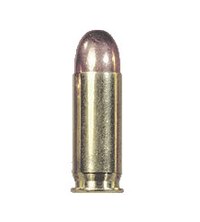.38 Super Auto
| .38 Super | ||||||||||||||||||||||||
|---|---|---|---|---|---|---|---|---|---|---|---|---|---|---|---|---|---|---|---|---|---|---|---|---|
 |
||||||||||||||||||||||||
| Type | Pistol | |||||||||||||||||||||||
| Place of origin |
|
|||||||||||||||||||||||
| Production history | ||||||||||||||||||||||||
| Manufacturer | Colt's Manufacturing Company | |||||||||||||||||||||||
| Produced | 1929 | |||||||||||||||||||||||
| Specifications | ||||||||||||||||||||||||
| Parent case | .38 ACP / .38 Auto | |||||||||||||||||||||||
| Bullet diameter | 9.04 mm (0.356 in) | |||||||||||||||||||||||
| Neck diameter | 9.75 mm (0.384 in) | |||||||||||||||||||||||
| Base diameter | 9.75 mm (0.384 in) | |||||||||||||||||||||||
| Rim diameter | 10.31 mm (0.406 in) | |||||||||||||||||||||||
| Rim thickness | 1.27 mm (0.050 in) | |||||||||||||||||||||||
| Case length | 22.86 mm (0.900 in) | |||||||||||||||||||||||
| Overall length | 32.51 mm (1.280 in) | |||||||||||||||||||||||
| Case capacity | 1.14 cm3 (17.6 gr H2O) | |||||||||||||||||||||||
| Rifling twist | 406 mm (1 in 16 in) | |||||||||||||||||||||||
| Primer type | Small pistol | |||||||||||||||||||||||
| Maximum pressure | 251.66 MPa (36,500 psi) | |||||||||||||||||||||||
| Ballistic performance | ||||||||||||||||||||||||
|
||||||||||||||||||||||||
|
Test barrel length: 5" Source(s): Accurate Powder |
||||||||||||||||||||||||
The .38 Super or .38 Super Automatic (C.I.P. designation) is a pistol cartridge that fires a 0.356-inch-diameter (9.04 mm) bullet. The Super was introduced in the late 1920s as a higher pressure loading of the .38 ACP or .38 Auto. The old .38 ACP propelled a 130-grain (8.4 g) bullet at 1,050 ft/s (320.0 m/s). The improved .38 Super Auto pushed the same 130-grain (8.4 g) bullet at 1,280 ft/s (390.1 m/s). The .38 Super has gained distinction as the caliber of choice for many top pistol match competitors; it remains one of the dominant calibers in IPSC competition.
The cartridge was designed for use in the M1911 pistol and was capable of penetrating the body armor and automobile bodies of the time. When the .357 Magnum was introduced in 1934, this advantage of the .38 Super was no longer enough to lure police departments and officers from the traditional revolver.
The .38 Super retains the original dimensions of the .38 ACP case. The cartridge was originally designed to headspace on the semi-rim, which worked in the Colt M1900 due to the design of the feed ramp. When the .38 Auto became the .38 Super, in the 1911A1, the feed ramp could no longer be used as rim support. As a result of this, observed accuracy of the .38 Super suffered until Irv Stone of Bar-Sto barrels re-designed the chamber to allow headspacing on the case mouth. Since then, all new production .38 Super pistols headspace on the case mouth, as with other cartridges in this class. The semi-rimmed case is known to cause feeding problems in some magazines, especially double stack magazines, and led to the development of new variants with reduced rims (typically only .003" per side).
In 1974 the industry added the +P headstamp to the .38 Super to further distinguish it from the lower-pressure .38 ACP. Most current ammunition manufacturers label ammunition for the Super as .38 Super +P.
...
Wikipedia
